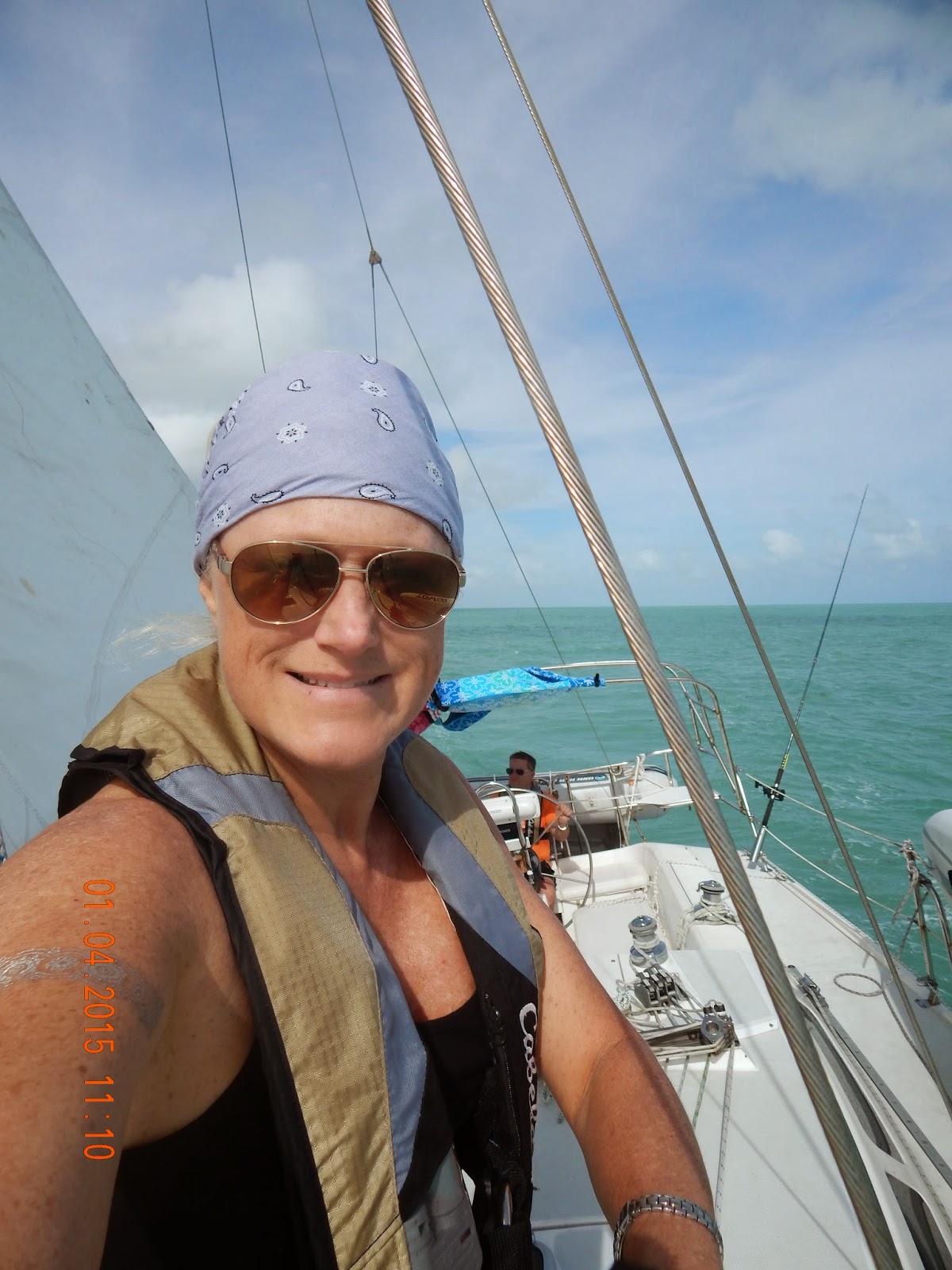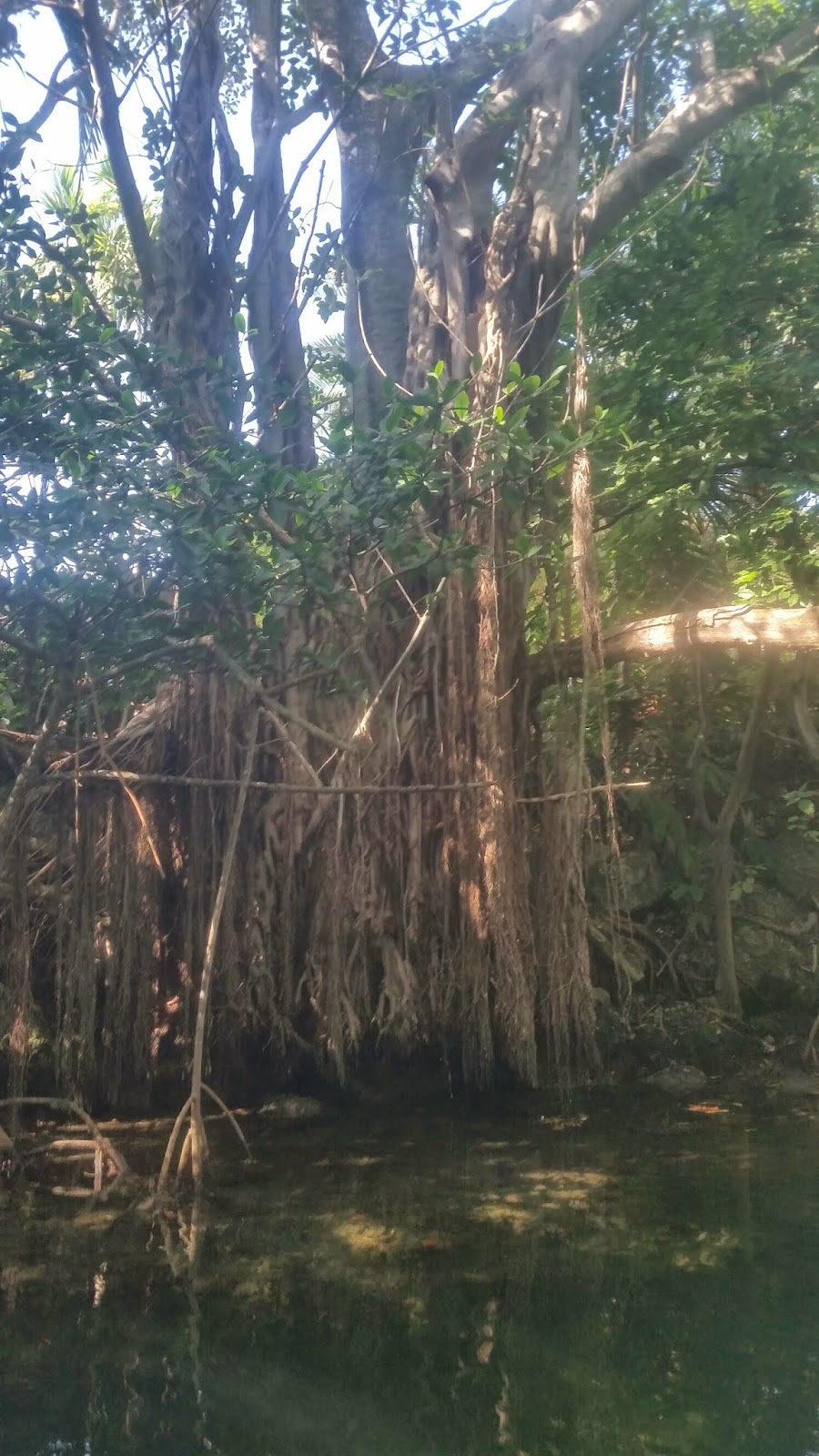After a pretty good night anchored right outside of No Name
Harbor, we headed out the channel and past the Cape Florida
lighthouse. This is a traditional looking lighthouse that is tall
and overlooks the big wide Atlantic Ocean.
Last night when we came to our spot for the night, it was
very dark . . . . I mean completely black. We could see the little
protected bay (called No Name Harbor) on the map, but weren’t sure if it would
deep enough for safe transit. And it wasn’t something we
really wanted to try in the pitch dark. As we went by the harbor entrance
in the morning light though, we could see quite a few sailboat masts inside, so
it must indeed be plenty deep.
As we passed by the point of Cape Florida (this is the very
end of Key Biscayne, by the way – some of the priciest real estate in America),
we were astonished to find we were in open ocean all around, but still needing
to follow the marked channel several miles offshore. The water on either
side of the channel was just 2 or 3 feet deep – and we were quite far offshore
already.
Once we left the flats, the water quickly deepened and we
turned south. The wind was really “up”. Our AWM (Apparent
Wind Monitor) on the top of the sailboat mast was showing readings of 16-19,
and some gusts of low 20s. This seemed pretty doggone windy to us.
We started with the genoa (headsail) unfurled about ½
way, but as we got more confidence and things were going good, we unfurled her
all the way and “let her rip”! We hadn’t yet installed any
reefing lines in the mainsail either, so we had full canvas up. I
was shocked to find out just how stable the boat felt. In our previous
boat (a Catalina 27), we were very much tossed over into a dramatic heel when
the wind gusted. In this boat (a Catalina 320), it was much MUCH
more stable. While I’m certainly no Naval Architect, I
“think” this was for two reasons: 1) size – this boat is 5 feet longer
and about 5,000 pounds heavier. Seems like it is just much
more solid and it takes a lot to move it. 2) design – the shape of the
wetted surface of the hull is very different. The Catalina 27 was shaped
mostly like a rounded U on the bottom. This boat (Catalina 320) is
like a much wider rounded U. it’s clearly got a wide flat spot on
the bottom before rounding up to the sides.
I think that translates into a lot more initial stability.
The aqua water of the Atlantic Ocean.
I am on the foredeck while Mark is captaining.
Take notice on the homemade bimini with our swim towels. The actual canvas had the zippers ripping out. They are now being repaired at the sailmaker so that we can use them in April.
This is where we anchored at Angelfish Creek. A few other boats were amongst us.
Beautiful sunset and un winding in the cockpit at the end of the day. The sunset is beautiful.
This is Pumpkin Key. We heard there was good snorkeling behind this island.
This is the cut that we took our paddleboards through.
Back to Endurance for another day of sailing.The aqua water of the Atlantic Ocean.
I am on the foredeck while Mark is captaining.
Take notice on the homemade bimini with our swim towels. The actual canvas had the zippers ripping out. They are now being repaired at the sailmaker so that we can use them in April.
In any case, it was very much more stable and comfortable in breezy conditions. There wasn’t one single time where we needed to grab either the Jib Sheet or the Main Sheet to dump wind, despite some pretty strong breeze.
We headed down south-ish. Our plan was to parallel the banks/keys. Interestingly enough, for the first 15 miles or so, there was nothing visible. It looked like we were completely offshore, however, the mapped showed that approximately ½ mile off our starboard side, the water was 0 to 1 feet deep in an impenetrable reef/bank. Strange. Nothing was visible at all.
We had planned to head through these banks at a place called Caeser Creek. We got lined up with the channel markers and started to head in. However, we soon noticed that the engine was badly overheating. YIKES! This was no place to be caught without working propulsion. I quickly whipped her around 180 degrees back to the East and raised the sails. Shawnae tacked back and forth across the entrance (in deep water) while I tore into the engine with all of my (LIMITED) mechanic-ing knowledge. It was difficult to troubleshoot with the swells, waves and high winds.
Eventually I made a decision that we needed to sail on an hour further to the south, and get “inside” at a place called Angelfish Creek. Angelfish looked to be a better, straighter, and deeper cut to attempt an entry under sail power alone – with NO engine backup.
It turned out to work very well. We had no problems navigating the twisting channel of Angelfish Creek. Upon crossing through the mangrove banks, we entered Card Sound. A short distance to the south found a nice spot to anchor close to Pumpkin Key.
This is where we anchored at Angelfish Creek. A few other boats were amongst us.
Beautiful sunset and un winding in the cockpit at the end of the day. The sunset is beautiful.
This is Pumpkin Key. We heard there was good snorkeling behind this island.
Once in a calm anchorage, we left the non-working engine alone and had a nice dinner. I also spent some time online with google searches on the overheating engine problem.
The next morning, based on what I learned through Google the night before, I narrowed down the problem to the seawater cooling pump. I took it apart completely. Fortunately, it didn’t appear to be damaged, just very “gunky”. I removed the impeller and O-rings and reconditioned them with silicon. Shawnae also buffed the pump backing plate with copper wool (like steel wool, but made from copper strips – it doesn’t rust in the saltwater). We put her back together and tightened the drive belt. And crossed our fingers. IT WORKS! Yahoo. We ran the engine for a while and nervously watched the temperature gauge, but it remained rock solid – right where it was supposed to be.
Having that problem “solved” (we hoped), we took off on the paddle boards and explored a bunch of canals that are part of the very exclusive Ocean Reef Club. Ocean Reef Club This was fun. We felt like we were kinda “sneaking in” although we weren’t doing anything wrong. BEAUTIFUL homes and tons of very expensive boats. The really “odd” thing though, was that we saw very few people. The beautiful gorgeous setting and people weren’t even using these homes or outside doing things.
This is the cut that we took our paddleboards through.
We are headed through the mangroves. They plant their roots in the water.
About noon, we were back at the boat, with muscles a little
tired from this new paddleboarding activity. A light lunch and we
headed off for Key Largo.
Stay tuned - - next chapter!!!
Stay tuned - - next chapter!!!












Looks like a great time, love the pictures! I hope our Catalina 30 feels as stable as your 32! =)
ReplyDeleteWe are really looking forward to going out there again in April. We already have our flight booked! I bet your 30; will do great!
ReplyDelete